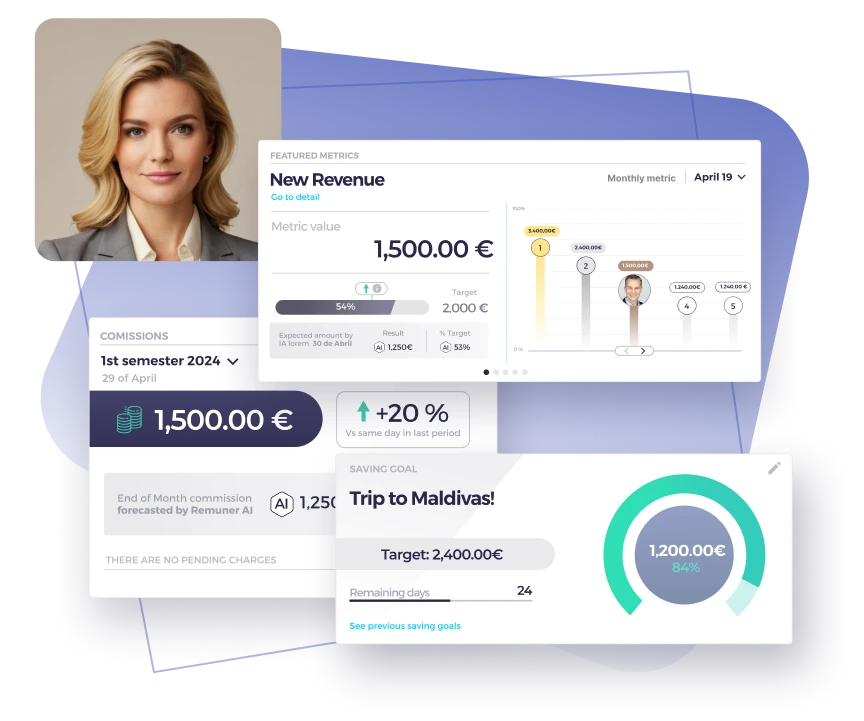Table of contents
What are sales performance metrics?
Sales performance metrics are quantifiable data points that reflect how well a sales team or individual sales rep is doing against defined sales goals. These metrics inform strategic decisions, help optimize compensation models, and align sales and marketing efforts.
Sales metrics vary by business model, but top-performing teams rely on consistent indicators tied to activity, outcomes, pipeline stages, and revenue.
Why sales performance metrics matter
Tracking these metrics empowers:
- Sales managers to spot underperformance or coaching opportunities
- Sales reps to self-optimize and understand their incentive path
- Leadership to allocate resources and set strategic direction
- HR and finance teams to tie compensation and OTE to performance fairly
By integrating metrics into daily workflows and dashboards, sales teams make real-time decisions that compound into long-term growth.
Types of sales performance metrics
We categorize the most valuable metrics into 4 core areas:
1. Activity Metrics
These reveal what your sales reps are doing daily to fill the pipeline.
- Calls per day: Number of sales calls made
- Emails sent: Outreach volume via email
- Meetings booked: Total scheduled meetings
- Follow-ups completed: Indicates consistency and persistence
Use Remuner to connect activity data with compensation triggers and incentives.
2. Pipeline Metrics
Track how leads move through the sales funnel.
- Lead response time: Speed of initial rep contact
- Opportunity-to-win ratio: Measures quality of deals entering pipeline
- Average deal size: Revenue potential per deal
- Stage conversion rate: Efficiency across each stage of the sales process
Use these metrics to set quotas that match expected conversion rates. Remuner can automatically align variable comp with each pipeline stage thanks to its compensation plan manager.
3. Outcome Metrics
Outcomes indicate real performance against company goals.
- Quota attainment rate: % of reps hitting quota
- Win rate: Deals won / deals proposed
- Closed deals per rep: Volume of signed contracts
- Customer acquisition cost (CAC): Total cost of acquiring a new customer
4. Revenue & Retention Metrics
Revenue-related metrics tie performance directly to bottom-line impact.
- Monthly recurring revenue (MRR)
- Customer lifetime value (CLV)
- Net revenue retention (NRR)
- Upsell/cross-sell rate
20 examples of essential sales performance metrics
Let’s look at real-world examples across different roles:
1. Win rate
This shows the percentage of deals a sales rep or team successfully closes. A high win rate means reps are qualifying leads well and managing the sales process effectively.
2. Average deal size:
Understanding the average revenue generated per deal helps with forecasting and determining whether your reps are targeting the right segment.
3. Quota attainment
The quota attainment metric reveals how many reps are meeting their sales targets. It also signals how realistic and motivating quotas are for your team.
4. Customer acquisition cost (CAC)
CAC tracks the cost to acquire a new customer, including marketing, sales salaries, tools, and other associated costs. A low CAC with high CLV indicates healthy profitability.
5. Sales velocity
A composite metric that considers the number of deals, average deal size, win rate, and length of the sales cycle. It tells you how quickly your team generates revenue.
6. Conversion rate
This measures how many leads turn into customers. Low conversion rates may suggest a problem with lead quality or the sales pitch.
7. Monthly recurring revenue (MRR) growth:
Especially important for SaaS businesses, MRR growth highlights recurring income and revenue predictability.
8. Follow-up rate
Follow-up actions can significantly impact close rates. This metric shows how proactive reps are at nurturing leads.
9. Deal slippage rate
The percentage of deals that were forecasted to close in a period but didn’t. High slippage can indicate forecasting issues or sales process inefficiencies.
10. Response time
The time taken to contact a lead after they express interest. Faster response times typically correlate with higher conversion.
11. Stage conversion rate
This tracks how effectively deals move from one sales funnel stage to the next. It helps identify bottlenecks in the sales process.
12. Calls per day
A basic yet telling activity metric. High-performing reps tend to have consistent outbound activity which drives pipeline.
13. Emails sent
Useful for measuring outreach campaigns, especially in SDR teams. Trends here can correlate with pipeline growth.
14. Meetings booked
Meetings represent deeper engagement and a more serious level of interest. Reps who consistently book meetings fill the funnel efficiently.
15. Customer churn rate
Shows how many customers leave during a specific period. High churn can hurt long-term revenue and indicates gaps in post-sale engagement.
16. Upsell/cross-sell rate
Measures revenue generated from existing customers through expanded offerings. Indicates sales team’s ability to deliver continued value.
17. Opportunity-to-win ratio
Reveals how many open opportunities result in wins. A low ratio might indicate that too many poor-fit leads are entering the pipeline.
18. Customer lifetime value (CLV)
CLV measures the total revenue a customer is expected to bring during their relationship with your company. Combined with CAC, it tells you how efficiently you’re scaling.
19. Sales forecast accuracy
Indicates how closely predicted results match actual performance. Inaccurate forecasting hurts planning and trust in sales leadership.
20. Lead-to-close ratio
A comprehensive efficiency metric that considers how many leads are required to close one deal. It’s useful for benchmarking rep effectiveness and pipeline quality.
All of these metrics can be tracked and tied to compensation using Remuner. If you want to discover how, book a free demo with our compensation team. They will guide you!
Connecting metrics to incentives, quota, and OTE
You can’t improve what you don’t measure. But metrics become even more powerful when they fuel:
- Quota setting: Using historical performance data to set fair, achievable quotas.
- OTE alignment: Ensuring that On-Target Earnings reflect real sales performance potential.
- Incentive triggers: Tying metrics like meetings booked, opportunities created, or revenue won to compensation.
Remuner automates these connections by linking CRM activity to compensation workflows.
How to choose the right sales performance metrics
Not all metrics are equally relevant to every team. Here’s how to narrow down:
- Match metrics to sales goals (e.g., acquisition vs retention)
- Align with sales process and rep responsibilities
- Prioritize real-time, actionable metrics
- Validate data integrity across tools and systems
- Involve sales managers in selecting and reviewing KPIs
Using real-time dashboards to track metrics
Static reports are outdated. High-performing sales teams use:
- Real-time dashboards with drill-down capabilities
- Automated alerts for quota attainment and pipeline slippage
- Mobile access for reps on the go
- Custom leaderboards to foster competition
Remuner offers real-time, customizable dashboards connected to compensation data. Start building dashboards that work for you and try it now.
How sales managers use performance metrics
Sales managers are the bridge between company goals and rep execution. They use performance metrics to:
- Coach reps at specific funnel stages
- Forecast with more accuracy
- Identify training needs
- Reallocate leads or territories
- Monitor incentive plan effectiveness
Remuner equips sales managers with granular rep-level analytics, quota progress, and coaching triggers. Discover how Remuner can help you with that incentive management.
Sales performance metrics and long-term strategy
Metrics aren’t just for short-term decisions. Over time, they:
- Uncover trends in sales and marketing alignment
- Inform sales strategies and process redesigns
- Feed back into lead scoring and sales funnel optimization
- Drive predictive sales forecasts
- Validate long-term compensation structures
By visualizing historical performance against quotas and OTEs, Remuner helps companies refine compensation over time. Explore long-term value.
Sales metrics and compensation automation
When your compensation system is manual, tying metrics to payouts becomes complex and error-prone. Sales reps lose trust, and finance teams waste time.
Instead, leading orgs:
- Automate comp calculations
- Visualize earnings in real time
- Sync CRM data with commission systems
- Align metrics, incentives, and targets seamlessly
Remuner automates the connection between sales activities and compensation, saving hours and improving accuracy. See automation in action.
FAQs about sales performance metrics
What are the most important sales performance metrics?
Key metrics include win rate, quota attainment, CAC, conversion rates, and MRR. The most important metrics vary by sales role and company objective.
How do sales metrics impact compensation?
Sales metrics serve as the foundation for quota setting, OTE design, and incentive triggers. Reps are rewarded for achieving or exceeding metrics tied to these goals.
Can I track metrics in real time?
Yes, with tools like Remuner, you can track performance in real time across roles, territories, and sales teams. This improves visibility and responsiveness.
How often should I review sales performance metrics?
Weekly for activity metrics, monthly for outcomes and pipeline movement, and quarterly for revenue trends and compensation reviews.
How do sales managers use performance metrics?
They use metrics to coach reps, forecast sales, improve team processes, and monitor incentive plan effectiveness.
Metrics, metrics and more metrics
Sales performance metrics are more than numbers, they’re the foundation of scalable, predictable revenue. The best sales teams use these metrics to drive action, not just reports.
Want to connect your sales metrics to a smarter compensation strategy?👉 Start using Remuner to unlock real-time performance insights, automate commissions, and motivate your team to hit every target.





